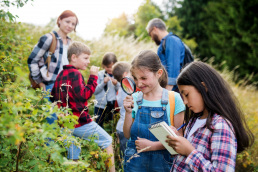

Lesson Plan:Multi-sensory Observing
Created in collaboration with Tracey Kline, Lynn Public Schools, Lynn, MA
Grades 6-8, CCSS.ELA-LITERACY.W.8.10
STANDARD
Common Core State Standards for English Language Arts & Literacy in History/Social Studies, Science, and Technical Subjects: CCSS.ELA-LITERACY.W.8.10 Write routinely over extended time frames (time for research, reflection, and revision) and shorter time frames (a single sitting or a day or two) for a range of discipline-specific tasks, purposes, and audiences.
LEARNING/ CONTENT/ LANGUAGE OBJECTIVE:
Students will be able to record observational science field notes in writing using multi-sensory observation skills.
LANGUAGE DEMAND:
Essential / Academic Vocabulary: observe/observation, multi-sensory, field journal + sensory vocabulary list
LESSON STRUCTURE
Lesson Beginning / Frame the Learning
(Clear entry routine, Do-Now, Activator, etc.; Frame the lesson by sharing and explaining lesson objective, agenda, and goals)
Differentiation
What supports and scaffolds am I providing based on the WIDA can-do descriptors?
![]()
![]()
![]()
![]()
![]()
![]()
![]()
![]()
![]()
![]()
- Link to Video: https://www.youtube.com/watch?v=wVyQ_8-k8Co
- Video in lesson slides provided in Lesson Resources below
![]()
![]()
![]()
![]()
![]()
![]()
![]()
![]()
![]()
![]()
![]()
![]()
![]()
- Provide word bank and sentence starters for students who need it.
Resource: WIDA can-do descriptors
Lesson Middle
(I do- teacher directed; We do- practice with the teacher; You do- partner/small group application with teacher support)
* Revisit language objective and agenda; formative assessment- check for understanding (intervention and extension opportunities available)
Differentiation
What supports and scaffolds am I providing based on the WIDA can-do descriptors?
![]()
![]()
![]()
![]()
![]()
![]()
![]()
![]()
![]()
![]()
- Link to video: https://youtu.be/93aMXg3GbdA
- Video in lesson slides provided in Lesson Resources below.
![]()
![]()
![]()
![]()
![]()
![]()
![]()
![]()
![]()
![]()
![]()
![]()
![]()
![]()
![]()
![]()
![]()
![]()
![]()
![]()
- Sensory vocabulary list provided in Lesson Resources below.
![]()
![]()
![]()
![]()
![]()
![]()
![]()
![]()
![]()
![]()
Student Directions:
- We will go outside as a class and stand/sit in one area near each other.
- Complete the 1 Observer journal together.
- Practice sharing observations for each of the categories using the Sensory Vocabulary List.
- Write notes
- Make 1-2 drawings in two categories of your choice.
- Then you will complete the 2nd Observer journal by yourself.
- Observer Journal Handout provide in Lesson Resources below.
![]()
![]()
![]()
![]()
![]()
![]()
![]()
![]()
![]()
![]()
- Resource Link: Google Maps to find latitude and longitude: https://eclipsesoundscapes.org/location-reporting-format/
![]()
![]()
![]()
![]()
![]()
![]()
![]()
![]()
![]()
![]()
![]()
![]()
![]()
Highlight specific words on the Sensory Vocabulary handout for students who may need extra support. By highlighting a smaller set of words, it allows students to focus their attention.
- Consider focusing on words that might already be in their vocabulary and cognates of their native language.
Resource: WIDA can-do descriptors
Lesson End
(You do- independent application; Summarize learning; Clear exit routine)
* Formative assessment-exit ticket, check for understanding, etc.
![]()
![]()
![]()
![]()
![]()
![]()
![]()
![]()
![]()
![]()
FORMATIVE ASSESSMENT
How am I measuring success? (Connection to your Content/ Language objective)
The teacher can measure student success by collecting field journal graphic organizers.
LESSON RESOURCES
- LINK TO Multi-sensory Observing LESSON PLAN (Google Doc): When you open this link you will be prompted to make a copy of the Google document. This will allow you to download, print, and/or edit the above lesson plan to best meet your needs.
- LINK TO Multi-sensory Observing SLIDES (Google Slides): When you open this link you will be prompted to make a copy of the Google slides. This will allow you to edit either of these slide options to best meet the needs of your classroom.
- LINK TO Sensory Vocabulary HANDOUT (Google Doc): When you open this link you will be prompted to make a copy of the Google document. This will allow you to download, print, and/edit the Google document to best meet the needs of your classroom.
- LINK TO Observer Field Journal HANDOUT (Google Doc): When you open this link you will be prompted to make a copy of the Google document. This will allow you to download, print, and/edit the Google document to best meet the needs of your classroom.
LESSON FEEDBACK
We want to hear from you! If you used this lesson plan or any of these resources, please submit lesson plan feedback via a short survey!